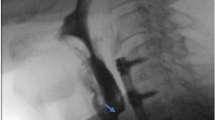Abstract
A barium swallow is an essential part of the workup of patients with esophageal disorders. This test defines the anatomy and is very useful for planning therapy. For instance, it is important preoperatively to distinguish a sliding from a paraesophageal hiatal hernia. In achalasia, it might also influence the decision for therapy depending on the size and shape of the esophagus. A CT scan and a PET scan are an essential part of the workup of patients with esophageal cancer to predict the response to neoadjuvant therapy. The goal of this chapter is to provide the reader with normal and pathologic reference images of the most common esophageal diseases and to illustrate how the radiologic evaluation is complementary, yet essential, for both the diagnosis and the surveillance of these disorders.
Access provided by Autonomous University of Puebla. Download chapter PDF
Similar content being viewed by others
Keywords
- Paraesophageal hernia
- Gastric volvulus
- Achalasia
- Sigmoid esophagus
- Diffuse esophageal spasm
- Zenker’s diverticulum
- Epiphrenic diverticulum
A barium swallow (Figs. 2.1, 2.2, 2.3, 2.4, 2.5, 2.6, 2.7, 2.8, 2.9, 2.10, 2.11, 2.12, 2.13, 2.14, 2.15, 2.16, 2.17, 2.18, 2.19, 2.20, 2.21, 2.22, 2.23, 2.24, 2.25) is an essential part of the workup of patients with esophageal disorders. This test defines the anatomy and is very useful for planning therapy. A CT scan (Figs. 2.26 and 2.27) and a PET scan (Fig. 2.28) are an essential part of the workup of patients with esophageal cancer. The goal of this chapter is to provide the reader with normal and pathologic reference images of the most common esophageal diseases and to illustrate how the radiologic evaluation is complementary, yet essential, in diagnosis and surveillance.
Suggested Reading
Abdelhakeem A, Patnana M, Wang X, et al. Influence of baseline positron emission tomography in metastatic gastroesophageal cancer on survival and response to therapy. Oncology. 2021;99:659–64.
Allaix ME, Borraez Segura BA, Herbella FA, Fisichella PM, Patti MG. Is resection of an esophageal epiphrenic diverticulum always necessary in the setting of achalasia? World J Surg. 2015;39:203-7.
Bello B, Zoccali M, Gullo R, Allais M, Gasparaitis A, Patti MG. GERD and antireflux surgery. What is the proper work-up? J Gastrointest Surg. 2013;17:14–20.
Blonski W, Kumar A, Feldman J, Richter JE. Timed barium swallow: diagnostic role and predictive value in untreated achalasia, esophagogastric junction outflow obstruction, and non-achalasia dysphagia. Am J Gastroenterol. 2018;113:196–203.
Hertault H, Gandon A, Behal H, et al. Incidence and risk factors for diaphragmatic herniation following esophagectomy for cancer. Ann Surg. 2021;274:758–65.
Ishaq S, Siau K, Lee M, et al. Zenker’s diverticulum: can protocolised measurements with barium swallow predict severity and treatment outcomes? The “Zen-Rad” study. Dysphagia. 2021;3:393–401.
Pauwels A, Boecxstaens V, Andrews CN, et al. How to select patients for antireflux surgery? The ICARUS guidelines (international consensus regarding preoperative examinations and clinical characteristics assessment to select adult patients for antireflux surgery). Gut. 2019;68:1928–41.
Plat VD, Bootsma BT, Straatman J, et al. The clinical suspicion of a leaking intrathoracic esophagogastric anastomosis: the role of CT imaging. J Thorac Dis. 2020;12:7182.
Schlottmann F, Andolfi C, Herbella FA, Rebecchi F, Allaix ME, Patti MG. GERD: presence and size of hiatal hernia influence clinical presentation, esophageal function, reflux profile, and degree of mucosal injury. Am Surg. 2018;84:978–82.
Weitzendorfer M, Köhler G, Antoniou SA, et al. Preoperative diagnosis of hiatal hernia: barium swallow X-ray, high-resolution manometry, or endoscopy? Eur Surg. 2017;49:210–7.
Author information
Authors and Affiliations
Corresponding author
Editor information
Editors and Affiliations
Rights and permissions
Copyright information
© 2022 The Author(s), under exclusive license to Springer Nature Switzerland AG
About this chapter
Cite this chapter
Patti, M.G., Herbella, F.A.M., Borraez, B. (2022). Radiologic Evaluation of Esophageal Diseases. In: Herbella, F.A.M., Patti, M.G. (eds) Atlas of Esophageal Surgery. Springer, Cham. https://doi.org/10.1007/978-3-031-12790-8_2
Download citation
DOI: https://doi.org/10.1007/978-3-031-12790-8_2
Published:
Publisher Name: Springer, Cham
Print ISBN: 978-3-031-12789-2
Online ISBN: 978-3-031-12790-8
eBook Packages: MedicineMedicine (R0)
































